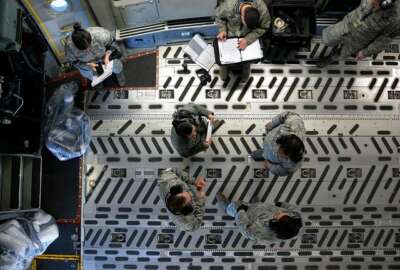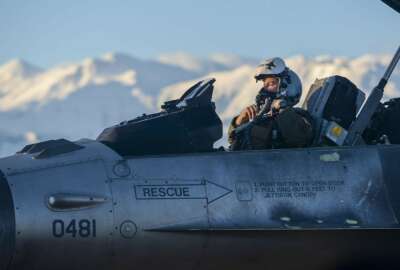
Air Force puts money where its mouth is to retain airmen
The 2018 budget proposal funds programs that will keep airmen in the service and better their life outside the military.
The Air Force is attempting to put its money where its mouth is when it comes to addressing retention and recruitment issues in 2018.
The 2018 budget proposal contains numerous requests for personnel programs that will help the Air Force grow and attract in-demand occupational specialists.
The Air Force seems to be leading the way in its efforts to shore up shortages in key military occupations compared to other military services by addressing issues holistically as it continues to grow its force.
The 2018 budget proposal asks Congress to increase the Air Force’s active duty end strength from 321,000 to 325,100, an estimated appropriation of about $2.1 billion.
In order to recruit the extra 4,000, the Air Force must also deal with an expected loss of about 57,000 airmen in 2018 from regular attrition.
The 2018 proposal asks for 200 recruiters and training personnel to open the pipeline for 29,000 new enlisted airmen.
To make Air Force life more appealing and hopefully retain more airmen in key positions, the budget proposal would fund or increase funding in a series of personnel programs.
“This budget will allow us to continue our progress in tackling maintenance manpower shortfalls, while also addressing critical capability gaps in critical career fields, such as nuclear, cyber and the [remote piloted aircraft] enterprise. To help with the retention, we will continue to offer incentive pays and bonuses to encourage experienced airmen to stay. We will also continue higher tenure extensions for personnel in key career fields to further retain experience,” Air Force Assistant Secretary for Budget Maj. Gen. James Martin said during a May 23 briefing at the Pentagon.
Lightening the load
As a means of easing the burden of additional duties on airmen, the service plans on increasing its commander support staff (CSS) by 1,600 over the next five years. About 200 will be added in 2018, Martin said.
That includes 170 officers, 469 enlisted airmen and 961 civilians. Those employees will be distributed to the nearly 2,000 active-duty squadrons.
Additional duties refer to responsibilities airmen are given at the unit-level that are not part of their regular job and can range from custodial tasks to security responsibilities.
Additional duties eat “up a lot of time and [are] frequently a big annoyance to the force. I’ve heard this over and over again as I’ve traveled,” former Air Force Secretary Deborah Lee James said last summer.
Brig. Gen. Stephen Davis, head of the Revitalizing Air Force Squadrons Task Force, was tasked by Air Force Chief of Staff Gen. David Goldfein to think of how the service can change its squadrons to make them more appealing to airmen.
Davis told Federal News Radio one of the most common things he’s heard in his travels is to get rid of extra duties.
Last year, the Air Force cut 29 extra duties. But many duties need to be done by someone and hiring a bigger staff will allow the Air Force to delegate those tasks away from busy airmen.
“The CSS provides critical support to the squadron, but not all of these positions were fully funded in the past,” Davis said. “We’re fixing that and will also add new positions to increase the level of CSS support for many squadrons. Fully funding the increased CSS requirement is a key element in revitalizing Air Force squadrons.”
Being Flexible
The Air Force now offers a preferences program for airmen who take a full year deployment. Officers and enlisted who volunteer for a year-long deployment can apply for an advanced follow-on assignment or a two-year deferment from a permanent change of station.
The Air Force is no stranger to programs like this. It is experimenting with a pilot that allows airmen to take a sabbatical from service to raise a family, care for a sick loved one or take a career advancing job in the private sector.
These programs harken back to conclusions made by multiple commissions and studies that state a flexible family life is what many in the military want from their employer.
“If the military is going to recruit and retain a volunteer force with the necessary skills, it needs to do two things. It needs to recruit, assign and promote in a way that develops and retains value across a wide range of skills including the highly technical skills, and it needs to better accommodate the evolution of American society and the American family. And it needs to do those things without sacrificing the aspects of the system that are working well,” former senator and Bipartisan Policy Center Personnel Reform Task Force member Jim Talent told Congress earlier this month.
Pilots
The 2018 budget will increase the bonus pay for pilots, as well.
“This budget begins to address the pilot shortage by adding training capacity in our formal training units, while also ingesting our incentive pay structure. It will provide the personnel to support two new F-16 flying training units and other initiatives to increase pilot production and training. We will increase pilot retention bonuses from $25,000 to $35,000 per year, the first increase since 1999,” Martin said.
The Air Force is short more than 1,500 pilots and is scrambling to keep them in the service. Many are going to work for private airlines instead of reenlisting after their initial 10 years in the service.
Goldfein hosted a National Pilot Sourcing meeting last week with airline executives to ensure high quality pilots of the needs of the nation.
RAND, the University of North Dakota, the National Air Carrier Association, Airlines for America, Civil Air Patrol, the Regional Airline Association and the Air Force briefed participants.
“I need 1,200 [pilots] a year, [the airlines] need 4,500 a year, for 10 years. They exhaust my supply pretty quick and they exhaust our supply pretty quick, so the next place they are going to go is international,” Goldfein told Federal News Radio last month. “We really have to look at this holistically to say, ‘What are the nation’s needs for a pilot force to do commercial business, private and military aviation?’ and then ‘How do we look at new creative ways of plussing-up the supply.”
A May 19 press release from the Air Force stated the Air Force and airline executives decided to work together to provide more accessible pathways for students of aviation to reach their goal and to create new pathways to becoming a pilot.
“Today’s aviation enterprise doesn’t adequately meet the needs for national defense and national commerce,” said Goldfein. “This is the beginning of something I think will have big payoffs if we’re disciplined in the way we approach it.”
Copyright © 2025 Federal News Network. All rights reserved. This website is not intended for users located within the European Economic Area.
Scott Maucione is a defense reporter for Federal News Network and reports on human capital, workforce and the Defense Department at-large.
Follow @smaucioneWFED





